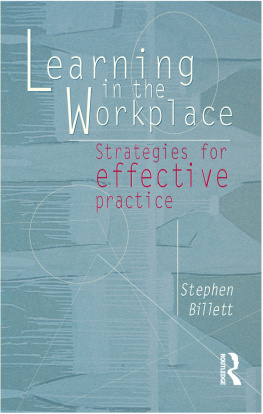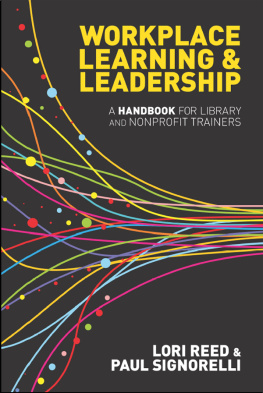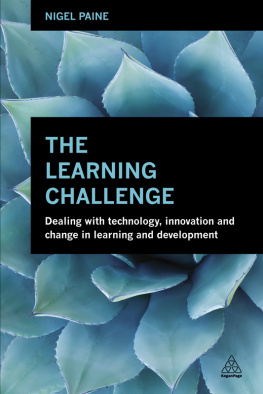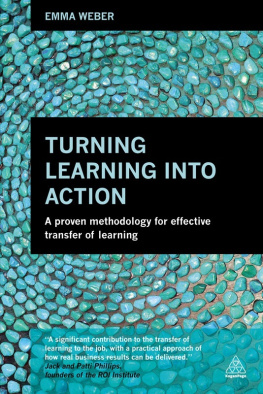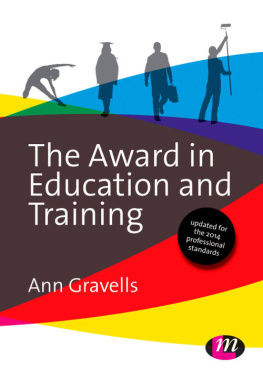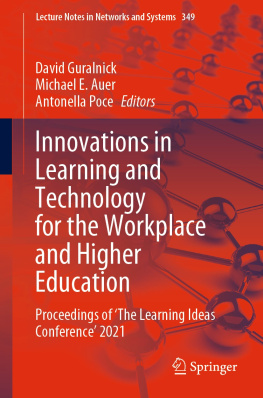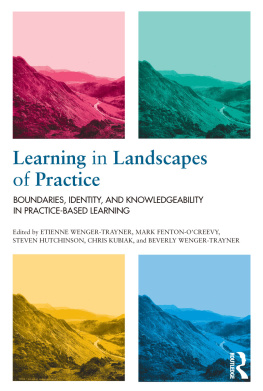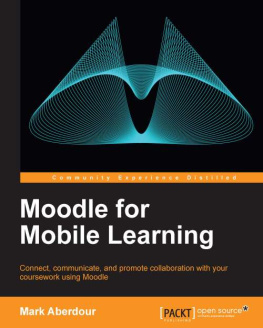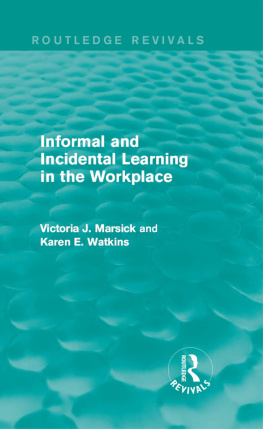LEARNING IN THE WORKPLACE
For AU and HGB
Learning in the workplace
Strategies for effective practice
Stephen Billett
First published 2001 by Allen & Unwin
Published 2020 by Routledge
2 Park Square, Milton Park, Abingdon, Oxon OX14 4RN
605 Third Avenue, New York, NY 10017
Routledge is an imprint of the Taylor & Francis Group, an informa business
Copyright Stephen Billett 2001
All rights reserved. No part of this book may be reprinted or reproduced or utilised in any form or by any electronic, mechanical, or other means, now known or hereafter invented, including photocopying and recording, or in any information storage or retrieval system, without permission in writing from the publishers.
Notice:
Product or corporate names may be trademarks or registered trademarks, and are used only for identification and explanation without intent to infringe.
National Library of Australia Cataloguing-in-Publication entry:
Billet, Stephen.
Learning in the workplace: strategies for effective practice.
Bibliography.
Includes index.
ISBN 1 86508 364 X.
1. Occupational training. 2. Employees Training of. I. Title.
658.3124
Set in 10/13pt Caslon540 by Midland Typesetters, Maryborough, Victoria
ISBN-13: 9781865083643 (pbk)
We often think of learning as the province of schools and colleges, as the outcome of teaching. We have all experienced life as students in the classroom and have often come to associate learning with what those places do. This is a misleading perception which can draw attention away from where learning really happens. Most of our learning did not occur there even when we were young; it certainly does not happen there in working life.
The workplace was once seen as a place to work, to produce goods or offer services. It was not the place to learn. Learning occurred before employment or as part of an apprenticeship or special training period. The demands of work have now become more complex. No amount of initial training can prepare someone for a lifetime of work. Jobs change, new technologies emerge, new opportunities are created. All this requires learning, and relearning.
Learning is in fact a normal human process that occurs throughout life, prompted by the events and challenges of everyday existence. It occurs everywhere. We all do it, all the time. We do it in the home, during leisure and at work. Only a small proportion of the learning in which we engage happens in classrooms or in conjunction with a formal course of study.
There has been a revolution in thinking over the past twenty years or so. In educational institutions the focus has moved decisively from teaching to learning. It has taken a long time to acknowledge that learning is everywhere. But now we are seeing an explosion of interest in the learning that takes place in adult life. Nowhere is this more true than in learning at work.
When learning was seen as the responsibility of teachers, the focus of research on teaching and learning was on what they did to foster it. Now that has begun to shift, research is taking place on what managers, supervisors and co-workers can do to help, how workplaces can be organised to promote the kinds of learning needed there and, indeed, on what employees can do to assist their own learning. This research is relatively new and it has yet to make a significant impact on working life.
Stephen Billett's book is therefore particularly timely. It is the first to take the increasingly large body of new research and thinking about work and learning and make it generally accessible. In particular, the book makes this knowledge available in ways that allow it to make an impact on how work is organised and structured. In discussing what he calls 'a curriculum for the workplace', the book shows how ideas about guided learning can be implemented in real settings. When applied in organisations, such rethinking of learning in work can be used to improve both productivity and the quality of working life.
The book is a revelation for those who may not be aware of the many recent studies illuminating learning at work. There are large number of examples from very diverse industries: from coal mining to hairdressing and from information technology to manufacturing. Although I have written in this area myself, I was surprised and delighted to see how Stephen Billett has drawn on so many interesting cases in so many settings. He has provided a sense of the richness and complexity of learning at work, while providing useful ways of looking at what can be done to positively influence it.
He writes as a leading researcher whose work has been internationally recognised and who has undertaken research on learning in many different workplaces. Unlike others, this book is not a prescription for a 'quick fit' for workplace problems. It provides practical solutions but in ways that enable readers to understand the issues involved and appreciate what might be needed in situations different to those described. The reader is stimulated to think through the implications of the important ideas that are lucidly discussed here and apply them in their own context,
Learning in the workplace has come of age with the publication of this book. It shows the way for a new level of sophistication in the ways learning and work are treated. It is respectful of the challenges of very many different types that are faced. And it opens new territory for exploration in the world of learning throughout life.
David Bond
Professor of Adult Education
University of Technology, Sydney
Contents
Guide
Accommodation Modification of existing cognitive structures when encountering a new task or stimulus that results in the development of new knowledge (categories or subsystems). A source of refinement to cognitive structures that does not abolish the established knowledge structures but differentiates them by introducing a new subsystem or category (Piaget 1976).
Appropriation The use of interpretative constructing knowledge derived from a social source which the individual 'makes their own'. Wertsch (1998) contrasts appropriationwhen individuals construct meaning empatheticallywith mastery reproducing some behaviour to which the individual is not wholly committed.
Assimilation Understanding a task or stimulus through the application of existing categories of knowledge. It involves incorporating task requirements or stimuli into existing knowledge structures (categories or subsystems) (Piaget 1966).
Automisation Any procedure that can be performed automatically without conscious thought, through a process of repeated rehearsal or practice as in proceduralisation (compilation and composition).
Chunking Developing associations between concepts to secure almost instantaneous categorisation of and response to tasks (Pea 1993); premised on the development of links between concepts (e.g. red = stop; green = go) until the use of one readily triggers the other.
Coaching Guidance and monitoring by a more experienced coworker or expert of learners conducting work activities. The provision of hints, feedback and clues, as well as demonstrating, modelling and explaining 'tricks of the trade' can assist the development and refinement of workplace procedures through coaching.

